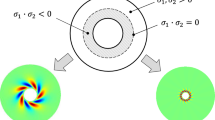Abstract
Bifurcations of a thin circular elastic plate subjected to uniform normal pressure are investigated by taking into account the in-plane compliance of the edge restraint. This effect amounts to introducing a Hookean spring relating the radial components of the membrane stress tensor and the corresponding in-plane displacement fields. The addition of this new feature gives rise to an adaptive radial stretching of our configuration, which is intimately linked to the strength of the applied pressure. The Föppl-von Kármán nonlinear plate theory, in conjunction with singular perturbation arguments, help us to establish the nature of the localised wrinkling observed in numerical simulations. Asymptotic analysis of the problem provides some simple qualitative predictions for the dependence of the critical load on a number of key dimensionless parameters.




Similar content being viewed by others
References
Bainov, D., Simeonov, P.: Integral Inequalities and Applications. Springer, New York (2013)
Bennati, S., Degl’innocenti, S., Padovani, C.: On the sign of the internal stresses in a problem of plane elasticity. J. Elast. 32, 155–174 (1993)
Cerda, E., Mahadevan, L.: Geometry and physics of wrinkling. Phys. Rev. Lett. 90, 074302 (2003)
Chia, C.Y.: Nonlinear Analysis of Plates. McGraw-Hill, New York (1980)
Coman, C.D.: Asymmetric bifurcations in a pressurised circular thin plate under initial tension. Mech. Res. Commun. 47, 11–17 (2013)
Coman, C.D., Matthews, M.T., Bassom, A.P.: Asymptotic phenomena in pressurised thin films. Proc. R. Soc. Lond. Ser. A, Math. Phys. Sci. 471, 20150471 (2015)
Coman, C.D., Bassom, A.P.: On the nonlinear membrane approximation and edge-wrinkling. Int. J. Solids Struct. 82, 85–94 (2016)
Croll, J.G.A.: A tension field solution for non-linear circular plates. In: Dawe, D.J., Horsington, R.W., Kamtekar, A.G., Little, G.H. (eds.) Aspects of the Analysis of Plate Structures. Oxford University Press, New York (1985)
Dickey, R.W.: The plane circular elastic surface under normal pressure. Arch. Ration. Mech. Anal. 26, 219–236 (1967)
Feng, L., Li, X., Shi, T.: Nonlinear large deflection of thin film overhung on compliant substrate using shaft-loaded blister test. J. Appl. Mech. 82, 091001 (2015)
Knops, R.J., Payne, L.E.: Uniqueness Theorems in Linear Elasticity. Springer, Berlin (1971)
Langhaar, H.L., Stippes, M.C.: Location of extreme stresses. J. Elast. 6, 83–87 (1976)
Mikulas, M.M.: Behaviour of a flat stretched membrane wrinkled by the rotation of an attached hub. Technical Report, NASA-TN D-2456 (1964)
Ng, T.T.: Edge effects in pressurized membranes. J. Eng. Mech. 128, 1100–1104 (2002)
Panov, D.Y., Feodosiev, V.I.: On the equilibrium and loss of stability of shallow shells in the case of large displacement. Prikl. Mat. Meh. 20, 389–406 (1948)
Reismann, H.: Elastic Plates: Theory and Application. Wiley, New York (1988)
Puntel, E., Deseri, L., Fried, E.: Wrinkling of a stretched thin sheet. J. Elast. 105, 137–170 (2011)
Shilkrut, D.I.: Stability of Nonlinear Shells. Elsevier, Amsterdam (2002)
Stein, M., Hedgepeth, J.M.: Analysis of partly wrinkled membranes. Technical Note, NASA-TN D-813 (1961)
Stroebel, G.J., Warner, W.H.: Stability and secondary bifurcations for von Kármán plates. J. Elast. 3, 185–202 (1973)
Timoshenko, S.P., Gere, J.M.: Theory of Plates and Shells, 2nd edn. McGraw-Hill, New York (1961)
Ventsel, E., Krauthammer, T.: Thin Plates and Shells: Theory, Analysis, and Applications. Dekker, New York (2001)
Williams, J.G.: Energy release rates for the peeling of flexible membranes and the analysis of blister tests. Int. J. Fract. 87, 265–288 (1997)
Zhao, M.H., Zhou, J., Yang, F., Liu, T., Zhang, T.Y.: Effects of substrate compliance on circular buckle delamination of thin films. Eng. Fract. Mech. 74, 2334–2351 (2007)
Acknowledgements
The referees are thanked for several useful comments that led to improvements in the presentation of this work.
Author information
Authors and Affiliations
Corresponding author
Appendices
Appendix A: Remarks on the Role of \(\Delta\)
Here we outline an argument to show that the compressive azimuthal pre-buckling stresses require that \(\Delta>0\). Our approach is partially inspired by the analysis of Shilkrut [18], who explored various qualitative properties of pressurised shallow spherical shells using a system of equations similar in spirit to (2.5). Since the problem we consider was not treated explicitly in [18], here we sketch how we can deduce that \(\Delta>0\) is the regime of interest.
By using the Green’s function for the linear operator \(\mathcal{L}_{0}\) given by (2.7) subject to those components of boundary conditions (2.8a), (2.8b) relating to \(\varPhi\), this function can be expressed as
where
We note that Dickey [9] used similar integral representations for Hencky’s membrane equation, which is obtained by dropping the bending stiffness from the FvK plate model.
If \(N_{rr}^{(0)}\) and \(N_{\theta\theta}^{(0)}\) denote the pre-buckling radial and azimuthal stresses, respectively, then \(N_{rr}^{(0)}(\rho) = \varPhi(\rho)/\rho\) and \(N_{\theta\theta}^{(0)}(\rho) = \varPhi'(\rho)\) for all \(\rho\in (0,1]\). The possibility of wrinkling requires that \(N_{\theta\theta}^{(0)}(\rho)<0\) for at least one \(\rho=\rho_{0}\in (0,1]\) and the inequality \(N_{rr}^{(0)}(\rho)<|N_{\theta\theta}^{(0)}(\rho)|\) must hold at such points. For our boundary conditions used here the mapping \(N_{\theta\theta }^{(0)}(\rho)\) is strictly monotonic decreasing, so if there are any compressive azimuthal stresses these will have to be confined to a region close to the outer rim of the plate. Before we confirm this statement rigorously, let us note that \(\varPhi'(0)=A>0\), a fact that can be checked by considering the function
which is continuously differentiable with \(\varphi'(\rho)<0\) and \(\varphi(1)=0\) so that \(\varphi(0)>0\).
Use of (A.1) and (A.2) reveals that
and if the right-hand side of (A.3) is positive then there are no compressive azimuthal stresses and hence no wrinkling is possible. This means that a necessary condition for the eigenproblem (3.2)–(3.3) to have a solution is that \(\Delta>0\).
The monotonic decreasing nature of the azimuthal stresses is readily established as follows. Equation (2.5b) implies that \(\rho^{2}\varPhi ''(\rho) + \rho\varPhi'(\rho)-\varPhi(\rho)\leq{0}\) and integration by parts of this inequality over \((0,\rho]\) shows that \((\varPhi(\rho)/\rho)'\leq{0}\), i.e., the radial stress is a monotonic decreasing function of \(\rho\in(0,1]\). Since \(\varPhi\) is a regular function, we can use this last result to write
Another appeal to (2.5b), this time in conjunction with (A.4), indicates that
This differential inequality is reminiscent of Grönwall’s Lemma (e.g., see [1]), which can be applied to the function \(v(\rho):=\varPhi(\rho)-\varPhi(0)\rho\). In the light of (A.5) this function satisfies \(v''(\rho)\leq-(1/\rho)v'(\rho)\) for all \(\rho\in(0,1]\) and so if \(\rho_{1}<\rho_{2}\) then
whence \(\varPhi'(\rho_{2})<\varPhi'(\rho_{1})\), that is, the mapping \(\rho \to\varPhi'(\rho)\equiv N_{\theta\theta}^{(0)}(\rho)\) is monotonic decreasing.
The inequality between \(N_{rr}^{(0)}\) and \(N_{\theta\theta}^{(0)}\) can be established in a very similar way, so we omit further details. We mention in passing that, within the framework of linear elasticity, finding the sign of internal stresses for solids subjected to surface loads has been discussed by Bennati et al. [2] and Langhaar & Stippes [12].
Appendix B: Coefficients of the Bifurcation Equations
The coefficients \(A_{ij}^{(k)}\) that appear in (3.2) are given by
\(\boldsymbol{A}_{3}\):
\(\boldsymbol{A}_{2}\):
\(\boldsymbol{A}_{1}\):
\(\boldsymbol{A}_{0}\):
Appendix C: Derivation of Boundary Condition (3.3d)
Equations (2.8a), (2.8b) and (3.3a)–(3.3c) are standard consequences of classical plate theory (e.g., see [16, 22]) and require little further discussion. The justification of the end constraint (3.3d) is less well known and so, for the sake of completeness, is sketched here.
In the FvK plate theory the membrane strain tensor \(\boldsymbol{e}\) takes the form
which is easily written in component form by recalling that in polar coordinates \(\boldsymbol{\nabla}\otimes\boldsymbol{u}\) assumes the following representation
The average extensional strains (C.1) are related to the membrane tensor \(\boldsymbol{N}\) through the usual Hooke’s law, that is \(\boldsymbol{e}= \mathbb {C}:\boldsymbol{N}\), where the compliance tensor ℂ can be expressed as \(\mathbb{C} = (Eh)^{-1} [(1+\nu)\boldsymbol{I}_{4} - \nu (\boldsymbol{I}_{2}\otimes\boldsymbol{I}_{2}) ]\), with \(\boldsymbol{I}_{4}\) and \(\boldsymbol{I}_{2}\) denoting the fourth- and second-order identity tensors, respectively.
Using all the above relations it is a routine matter to establish that
The next step is to express (C.2) in terms of \(\varPsi\) and \(W\). By making use of (2.2) together with (C.1) and the aforementioned Hooke’s law, we can re-cast (C.2) as
Finally, by letting \(\rho=1\) in this equation and using (3.1), we arrive at the boundary constraint (3.3d) after linearising the quadratic term in (C.3) as explained in Sect. 2.
Appendix D: Derivation of Some Key Asymptotic Scalings
In order to justify some of key asymptotic scalings that appear in the calculations, here we outline in more detail how the results arise. Let us first consider the nature of the basic structure when \(\lambda\gg1\) and it is recalled that the associated problem is given by (2.5)
to be solved subject to
Now to ascertain the key scalings the following observations are made. If we consider the majority of the plate \(0\leq\rho\leq1\) away from the rim it is clear that within (D.1a) the first term on the right hand-side is of size \(\mathcal{O}(\lambda)\) so that in order to achieve a suitable balance either \(\mathcal{L}_{0}[\varTheta ]=\mathcal{O}(\lambda)\) or \(\varTheta\varPhi=\mathcal{O}(\lambda)\). Let us assume the former. Then the right-hand side of (D.1b) would be of size \(\mathcal{O}(\lambda^{2})\) meaning that terms in this equation can only be balanced if \(\varPhi=\mathcal{O}(\lambda^{2})\) which in turn would imply that the last term in (D.1a) is of size \(\mathcal{O}(\lambda^{3})\). No other term in the equation can be that large so we must reject the notion \(\mathcal{L}_{0}[\varTheta]=\mathcal{O}(\lambda )\) and instead examine the possibility that \(\varTheta\varPhi=\mathcal{O}(\lambda)\). Now the two sides of (D.1b) are in balance if \(\varPhi\sim\varTheta^{2}\) so these two scalings together imply that \(\varTheta=\mathcal{O}(\lambda^{1/3})\) and \(\varPhi=\mathcal{O}(\lambda ^{2/3})\). From this we can deduce the sizes of the correction terms away from \(\rho=1\) since the left hand side of (D.1a) is \(\mathcal{O}(\lambda^{-2/3})\) smaller than the right. Hence we would expect the expansions for \(\varTheta\) and \(\varPhi\) to develop in powers of \(\lambda^{-2/3}\) as specified in (5.1).
As explained in Sect. 5.1 this structure needs to be supplemented by an appropriate zone attached to the rim \(\rho=1\) because the second-order problem for \(\phi_{0}\) and \(\rho_{0}\) described there cannot satisfy both rim boundary conditions. This is a direct consequence of the fact that at leading order the \(\mathcal{L}_{0}[\varTheta]\) term drops from (D.1a). If the rim boundary layer is of extent \(\rho=1-\mathcal{O}(\delta)\) then as \(\mathcal{L}_{0}\) involves a second-order derivative we expect that within the boundary layer \(\mathcal{L}_{0}[\varTheta]\sim\varTheta /\delta^{2}\sim\lambda^{1/3}/\delta^{2}\). As the right hand side of (D.1a) remains \(\mathcal{O}(\lambda)\) then the operator \(\mathcal{L}_{0}[\varTheta]\) is brought into play when \(\lambda^{1/3}/\delta^{2}\sim\lambda\) or \(\delta\sim\lambda ^{-1/3}\). This is the scaling predicted in Sect. 5.1 but, for the reasons outlined there, does not require consideration to the orders with which we are concerned.
4.1 D.1 The Right-Hand Branch
Here we consider the nature of the perturbation problem as far as it relates to the right-hand branch with \(m\gg1\) and discussed in Sect. 5.2. The important scalings can be inferred once it is realised that in bifurcation problems such as those encountered here, where a disturbance has to both satisfy a rim condition and to decay appropriately away from it, the driving differential equation is usually of second order. Moreover it is imperative that variation of the basic state is incorporated into the driving equation as solutions of a constant-coefficient equation are unable to fulfil both the rim and decay requirements. With these remarks to hand let us suppose that on the right-hand branch the perturbation rim layer has \(\rho=1-\lambda^{-p}Y\) and \(m=\lambda^{q}M_{0}\), where \(p\) and \(q\) are to be determined.
We start by noting that since \(\varPhi=\mathcal{O}(\lambda^{2/3})\), where \(\rho =O(1)\), then for \(\rho= 1-\lambda^{-p}Y\) a standard Taylor series would predict that
A simple inspection of the bifurcation system suggests that the coefficient \(\mathcal{A}_{11}^{(0)}\) is the largest in the first equation so must vanish at leading order. This is only possible if \(m^{2}\sim\lambda ^{2/3}\) whence \(m\sim\lambda^{1/3}\) as proposed in (5.5). This determined, all that remains is to settle the appropriate lengthscale. Now the first spatially varying term is \(d\varPhi/d\rho=\mathcal{O}(\lambda^{\frac{2}{3}-p})\), which gives rise to \(Y\)-variation in the coefficient \(\mathcal{A}_{11}^{(0)}\) of size \(\mathcal{O}(m^{2}\lambda^{\frac{2}{3}-p})=\mathcal{O}(\lambda^{\frac{4}{3}-p})\). This dependence should be of comparable size of the second-order derivative term \(\mathcal {A}_{11}^{(2)}(d^{2}W/d\rho^{2})=\mathcal{O}(m^{2}\lambda^{2p})=\mathcal{O}(\lambda^{\frac{2}{3}+2p})\). Since
this implies the important finding that the perturbation lies where \(\rho=1-\lambda^{-2/9}Y\), as noted in (5.3). Given these predictions for the important lengthscale and the corresponding mode number, the remainder of Sect. 5.2 is reduced to a little more than an exercise in careful algebra.
Rights and permissions
About this article
Cite this article
Coman, C.D., Bassom, A.P. On the Role of In-Plane Compliance in Edge Wrinkling. J Elast 126, 135–154 (2017). https://doi.org/10.1007/s10659-016-9584-3
Received:
Published:
Issue Date:
DOI: https://doi.org/10.1007/s10659-016-9584-3




